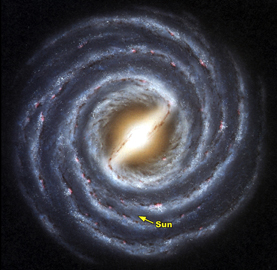|
Newsletter: Our Sun’s Migration:
Downtown to the Suburbs
Our galaxy, the Milky Way, is described as a barred spiral galaxy. This NASA/JPL/Caltech image is our best estimate of what it looks from far above its center.
 Our Sun was born near the center of the Milky Way, and migrated out to the galactic suburbs, according to a recent paper. Authors Takuji Tsujimoto and Junichi Baba of Japan’s National Astronomical Observatory say our galaxy’s spiral arms drove this migration. Our Sun was born near the center of the Milky Way, and migrated out to the galactic suburbs, according to a recent paper. Authors Takuji Tsujimoto and Junichi Baba of Japan’s National Astronomical Observatory say our galaxy’s spiral arms drove this migration.
The spiral arms are not rigid objects. Each star moves independently, subject only to the gravity of the other stars and a dark matter halo. The latest estimates say our galaxy contains: (1) 250 billion stars in a disk that is 2,600 light-years thick and over 100,000 light-years across, and (2) a dark matter halo with a mass of nearly 1 trillion Msun (mass of our Sun) that spans nearly 2 million light-years.
The density of stars is greatest in the central bulge, central bar, and spiral arms, which is why they look brighter in the above image. Arms emanate from each end of the bar and spiral outwards, splitting into more and more arms.
Our Sun is now located 27,000 light-years from the galactic center, about halfway to the edge of the most visible region. But, Tsujimoto and Baba say it originated in the inner disk and migrated outward over the following 4.56 billion years. Their claim is based on how the abundance of iron varies with the distance from the galaxy’s center, and how it has evolved over time.
Iron is the end product of nuclear fusion in the most massive stars. Iron abundance in interstellar gas builds gradually as massive stars end their lives in cataclysmic explosions that seed their surroundings with iron and other elements.
Due to its high mass density, the rate of massive star formation and death is far greater in the galaxy’s core than in its periphery. Hence, iron abundance builds more rapidly and to higher levels in the core than in the periphery.
From our Sun’s measured iron abundance and known age, Tsujimoto and Baba estimate it was born about 12,000 light-years from the galactic center.
In their analysis, the spiral arms are key. They say spiral arms are pressure waves that periodically appear due to the central bar’s motion, and then fade away over many hundred million years.

The authors say, over billions of years, stars are swept up by passing spiral arms, sometimes lingering within the arms for prolonged periods. Angular momentum can be transferred from the arms to these stars, sometimes pulling stars inward towards the galactic center and sometimes pushing them outward, as illustrated here. On average, the outward pushes seem more forceful.
While within spiral arms, the authors say, the Solar System was exposed to “enormous irradiation” from supernovae, with probably “catastrophic climate change on Earth”. (Increased cosmic ray flux is linked to increased cloud cover and lower temperatures on Earth.) The blue zones above denote times when ice covered all Earth’s surface.
It’s an intriguing tale, and if true is another remarkably special feature of our planet. Our Sun was born where iron, carbon, oxygen and other vital elements were most abundant, and then migrated away from the intense radiation of downtown Milky Way, to its benign suburbs where life can thrive.

Have a Happy Thanksgiving and Stay Safe!

Best Regards,
Robert
November 2020
Note: Previous newsletters can be found on my website.
|